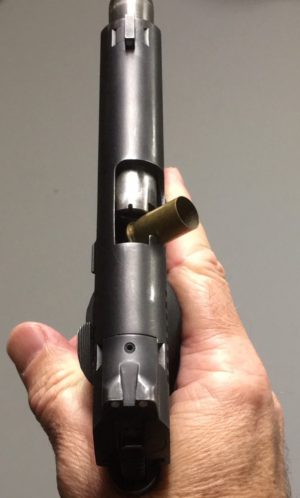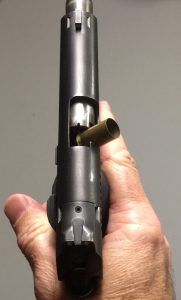The Type 2 Handgun Malfunction
What is a Type 2 Malfunction?
The Type 2 malfunction, also referred to as a “stovepipe”, is a common handgun malfunction. Fortunately, it is quick and easy to clear, and with practice, can be cleared in less than 1 second!
See Type 1 and Type 3 malfunctions.
Learning to clear this type of malfunction is a critical defensive handgun technique.
The definition of a Type 2 malfunction is a “failure to eject”. This means that after a round is fired, the empty brass fails to be fully ejected from the action and has become stuck, preventing the gun from fully cycling and firing the next round.
The symptom of a type 2 malfunction is a “dead” trigger when trying to fire a round. When you experience a dead trigger, you must quickly look at the gun to diagnose the exact problem. In this case, you would see brass stuck in the ejection port.
At the range, this is just an inconvenience, but if you are on the street fighting for your life, a delay in fixing this malfunction could be deadly.
What Causes This Malfunction?
A malfunction like this can happen when the gun ejector does not get a good grip on the round and has trouble ejecting the brass completely before the slide comes forward to load the next round into the chamber. This can also occur as a result of “limp wristing” which is an operator error in which the wrist or grip on the gun is too loose. A loose grip will prevent the gun from cycling properly as it does not have a firm “backstop” to push against while the spring loaded action is cycling.
Regardless of the reason for the malfunction, you need to clear the brass from the action and get a good round into the chamber as fast as possible to get the gun back in operating condition.
This is accomplished almost exactly the same way as a Type 1 malfunction.
Type 1 vs Type 2 Malfunctions
There is an important difference between a Type 1 and a type 2 malfunction: the symptom is different. The symptom for type 1 is a “click” when the trigger is pressed. This indicates the gun is in battery and functioning correctly and the issue is a problem with the ammo or magazine. A type 2 symptom is a “dead” trigger, meaning the gun is not functioning, likely because the action has not completely cycled.
A dead trigger is not enough information to diagnose the problem, so a quick look at the ejection port is necessary to determine the proper clearing technique. If you are in a gunfight when this occurs (and you should train as if you are) you should move to cover as soon as you get a dead trigger as you glance at the ejection port to see what is going on.
Type 2 Malfunction Drill
You can practice this drill at home using dry fire with dummy rounds or snap caps.
Be sure to verify that your firearm is unloaded and you are always pointing it in a safe direction when performing any drills. It is recommended to remove ALL live ammunition form the room that you will be using to practice your drills.
Type 2 Malfunction Drill Step-by-Step
So, the steps to clearing this malfunction are:
1. When dead trigger occurs, remove finger from trigger and place it straight along the side of the weapon.
2. Keeping the gun high and pointed in on target, quickly look at the ejection port as you move to cover.
3. In the case of a Type 2 malfunction, you will see brass is stuck “high” in the ejection port.
4. Remove the support hand from the grip and use it to “tap” or strike the bottom of the magazine with your palm to ensure it is properly seated.
5. Rack the slide as you tilt the gun 90 degrees to the right to load a new round into the chamber. Keep the gun high and pointed on target.
6. Place your trigger finger back on the trigger.
7. Do not press the trigger until you assess the situation and determine that another round needs to be fired.
Other Methods of Clearing a Type 2 Malfunction
There is a common malfunction clearing technique (not recommended) called “Tap, Rack, Bang”. YOU SHOULD NOT USE THIS METHOD. If you have been taught this and are practicing it, STOP. For more on this, see the explanation in my article: Type 1 Malfunction Drill.
This drill is designed to train you to quickly get “back into the fight” if a Type 2 Malfunction occurs while you are in a gunfight for your life (or in competition). You should practice this until it becomes second nature and you can clear the problem in 2 seconds or less.
There is another popular method to clear a Type 2 Malfunction that has come to my attention. This method uses a sweeping motion across the top of the slide to “sweep” the stuck brass out of the ejection port, thus allowing the slide to close and shooting to continue. This method is extremely quick, and appears to work well.
I have seen this demonstrated on Youtube and when it is set up by the operator, seems to be a great clearing method.
I have not tried this in a real “stovepipe” situation so at this time I cannot recommend it. My concern is that without the momentum of the slide moving forward under spring tension, the slide may not go completely into battery and therefore may not fire. I know my 1911 is finicky in this way, so I will stick to the method outlined in this article for now.
I would encourage you to try both methods when you experience this type of malfunction out on the range and decide for yourself.
Summary
Summing it up, when you have a dead trigger, remove your finger from the trigger, look at the ejection port (if it is a type 2, you will see brass stuck high in the action), move to cover or concealment, smack the bottom of the magazine with your support side palm, rack the slide as you tilt the gun 90 degrees, and place your finger back on the trigger. Then make a conscious decision whether to shoot or not.
Further definitions of firearm malfunctions can also be found at Wikipedia.
Also see Tactical Reload Drill and Emergency Reload here.
Please leave comments below if you have questions, opinions, or a better way! I read and reply to all of my comments!

